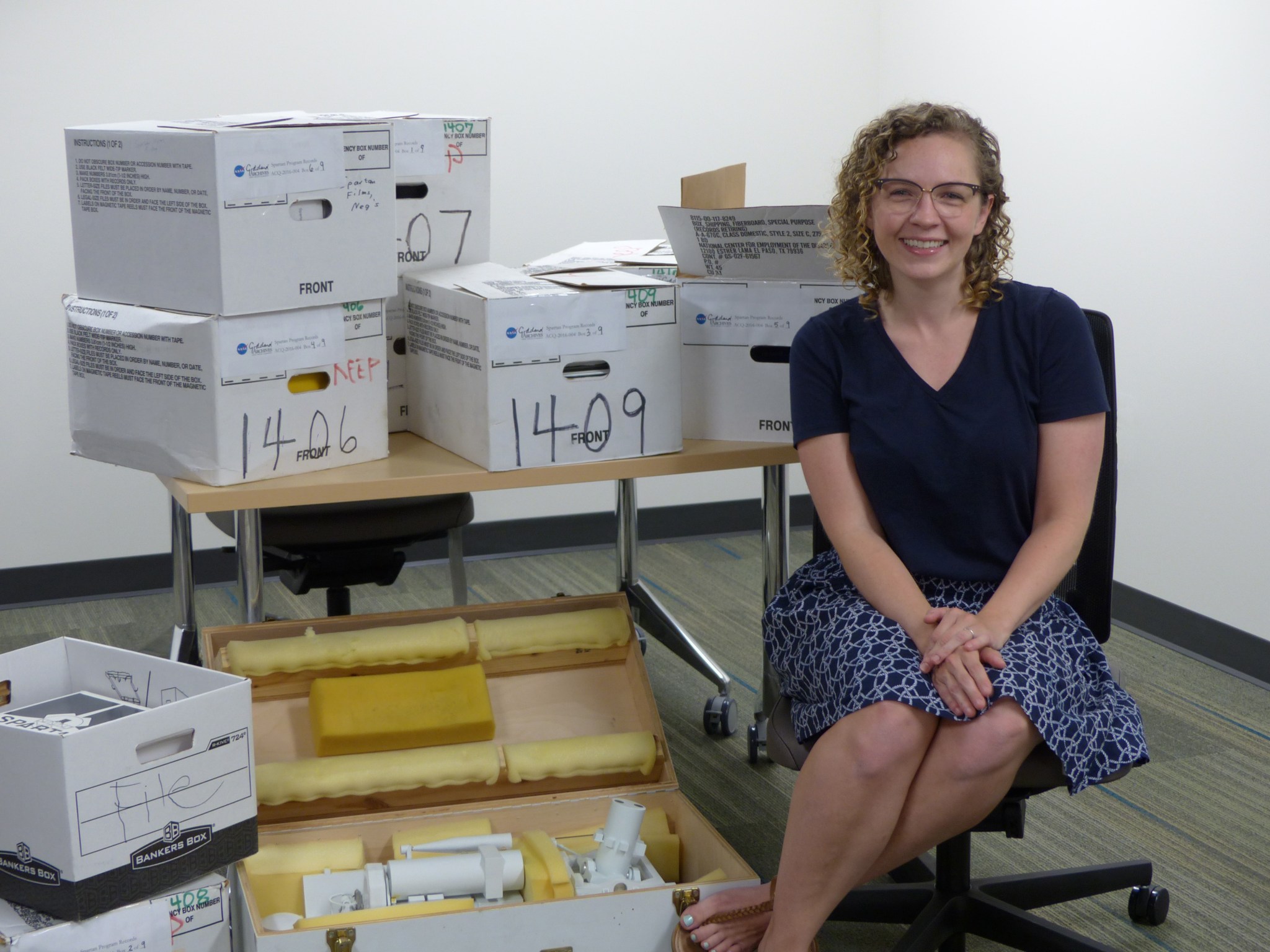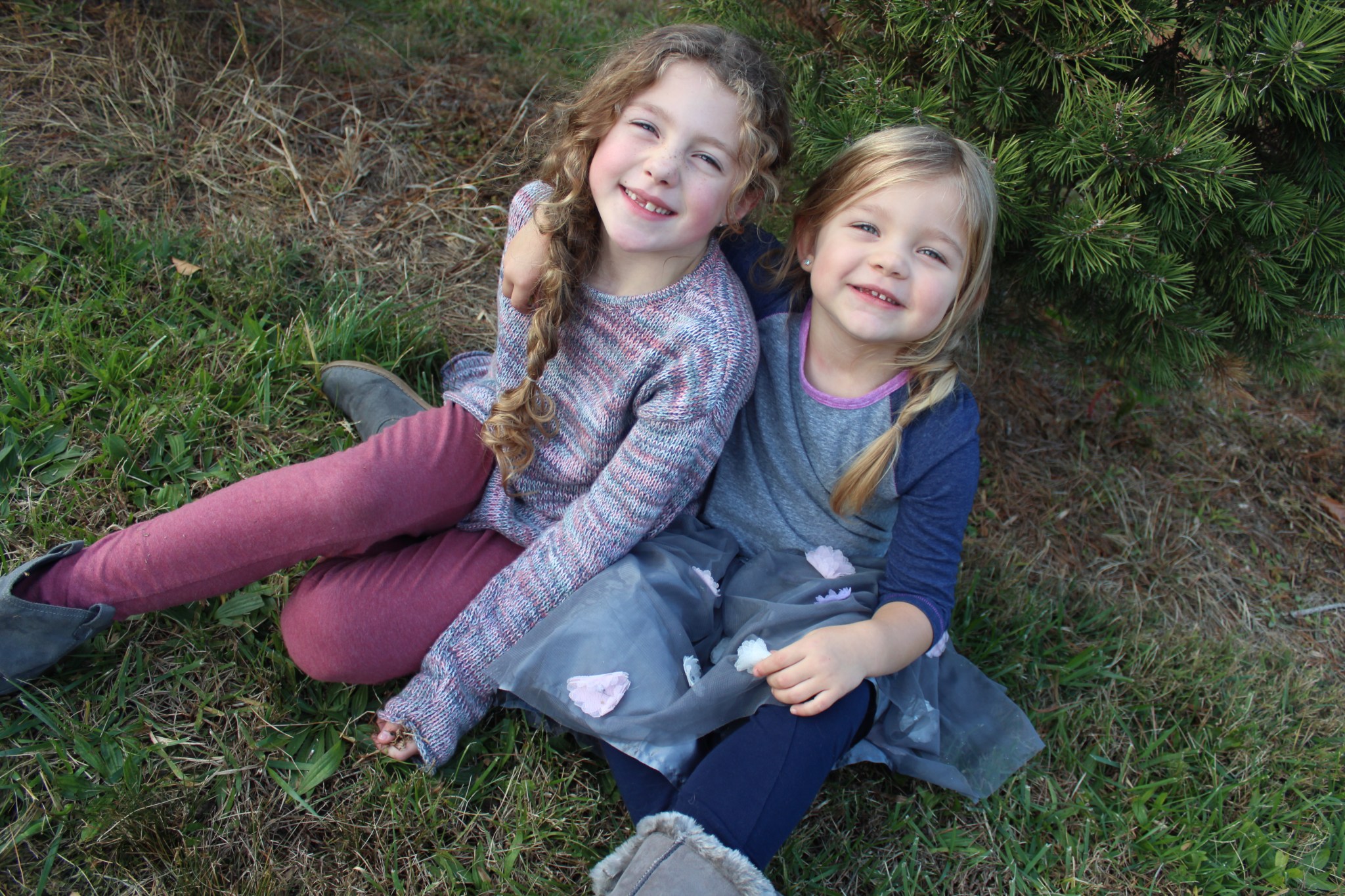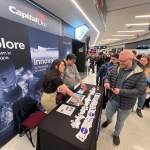Name: Holly McIntyre-DeWitt
Formal Job Classification: Archivist
Organization: Code 272.0 Knowledge Resources and Library Services Branch
What is your role at NASA?
I am the center archivist for NASA’s Goddard Space Flight Center, which means I serve the Greenbelt campus, Wallops Flight Facility in Chincoteague Island, VA, Independent Verification and Validation Facility in Fairmont, WV and Goddard Institute for Space Studies in New York, NY.
What is your typical day on the job like for you?
The cool thing about being a center archivist is that my job is incredibly varied. Every day is kind of different and I get to perform all the roles of an archivist. That would include doing outreach and education, getting out there and talking to folks about what records are and how these records fit into the mission of the Goddard Archives. I’m responsible for identifying what records have been created and where these records may be, whether in an office, a home, or in storage. The identification task quickly morphs into conducting appraisal visits, which means I go and take a look at a set of records, talk to the creator of those records and determine the historical significance of these records. If the records are determined to be historically significant, the Goddard Archives takes custody. Another archival task is processing records. Because I’m just starting the archives I haven’t had the chance to do a lot of processing yet. Processing records involves arranging the records to preserve the context with which they were created, creating descriptions of the records using metadata, and making those descriptions accessible online through some type of catalog system or electronic finding aid. That’s when the real fun will start. I like the prep work that goes into setting up an archives, but it will be really rewarding to be able to get the description of those records online so that other people can access and use Goddard Archives’ holdings. I’m stoked for that! Another archival task that I do is reference work. Even though the archives are in its infancy, I do field reference-related questions, both from other NASA archives and people on and off center who are looking for particular records. Reference is a huge part of archival work and will be an even bigger part once I make the Archives’ holdings accessible online.
Why did you choose your profession?
I don’t know if all archivists say this, but, I kind of fell into it. Unlike a lot of archivists, I actually come from a media background rather than a history background. I have my bachelor’s in motion picture film, and I started doing motion picture film preservation. I got a job at the National Archives and Records Administration in their conservation lab doing textual preservation work. While at the National Archives, I began to fall in love with the archival mission and really liked being a civil servant. I love being able to preserve our nation’s history and make it accessible to the public, because not every country does that; not every country feels the responsibility of making its processes and transactions transparent and accessible to the public. Being a part of that mission was so rewarding that I decided to further my career and my education and go into the archives realm. I got my master’s in library science with an archives specialization. Preservation is a huge part of the archival mission and I consider myself fortunate to have come from that background.
Why did you come to work at Goddard and what makes you stay?
In my capacity as an archivist for the National Archives, I had done a lot of accessioning and appraisal work with other NASA centers, including Goddard. All of my interactions with NASA employees were delightful and I just really appreciated the NASA mission and culture. So when I saw a job listing for the Goddard Space Flight Center archivist, I mean, who doesn’t want to work for NASA? I applied for it and I got the job, which was incredible. It was a little scary, too, because I had been at the National Archives for over eight years, that’s where I did my growing up, and stepping outside of my comfort zone and coming to a place where I don’t have a background in science or engineering was scary, but also exhilarating. I’m so proud to work at NASA and to be a part of that mission. I think that’s why I stay, because it’s a challenge in my own right. I’m up for the challenge and every day is an adventure.
What is one thing you would tell somebody just starting their career at Goddard?
I don’t know if I’ve been here long enough to answer that. I’ve only been here since October. I suppose one of the things I’ve been fortunate to do, because I’m the center archivist, is regularly reaching outside of my code and explore what the rest of the people here at Goddard do. I get to go across the organization and introduce myself and learn about what other people are doing and creating. Figuring out how everything works in the organization and how my Archives fits into the bigger picture I’d encourage people to go to all of those great colloquium series that are offered across the center; they’re fantastic. They definitely help you to learn about what your Goddard colleagues are doing and how it relates to the work that you are doing. So, I guess if I were saying anything to someone new at Goddard, I would say, “Get out there and be a part of the Goddard community and learn as much as you can because that helps you to be a better part of the mission.”
What is the coolest thing you’ve ever done as part of your job at Goddard?
To be quite honest, every day is super cool and just interacting with the scientists and engineers and hearing the stuff that they’re doing and their incredible achievements. Like I was listening to NPR and they were talking about the Juno insertion and I had a huge smile on my face. I was so proud! Every day hearing about what the people here are doing and myself, being a small part of that, is definitely cool.
If you weren’t in your current profession, what would you be doing?
Writing and illustrating children’s books. That’s my second career goal for when my kids are grown and I have more time on my hands. I love children’s books and I really enjoy drawing and painting. My kids definitely serve as my inspiration. They’re so quirky, adventurous, and fun. And every day I’m thinking about these different narratives and adventures that I’d love to get on paper and share.
Who are the most influential people in your life?
My children – just seeing their little, natural personalities and getting to see the world through their eyes is an incredible experience and a good reminder of what is important in life. Every day they influence me in the best ways and inspire me to have a greater appreciation for the little things. They are definitely the coolest people I’ve ever met, if I do say so myself.
What is an activity or hobby that you do outside of work that people do not generally know about you?
I don’t really do a lot, because I’m so busy at work and my kids are little so I’m busy raising them. I guess theorizing about children’s book themes is what I do constantly. If I’m zoning out or staring and drinking coffee; I’m probably thinking about children’s book narratives.
What is your “six-word memoir”?
Curly hair, don’t care. That can basically sum up my entire life.
Is there anything else you would like to say?
Goddard has never had an archives nor has it had a history office. I’m tasked with capturing over 55 years of history. The Goddard archives is still in its infancy right now and I’m excited to be growing this little baby for the center. I appreciate all of the help and knowledge I can get. Everyone that I’ve met with has been so welcoming, encouraging, and excited to help capture this history. I guess what I’d like to say; is thank you for the support. I’m really starting to do more outreach and meeting with a lot of different groups across the center. I’m working on getting a Facebook page and a blog started, so I encourage anyone who’s interested in Goddard’s history, regardless what it is that they do here, to get in touch with me to learn more about the Goddard Archives. If they have records that they think are historically significant or if they want to tell me stories about their history at Goddard, please contact me. That’s what I’m here for; I’m here to serve the center and preserve the center’s history.
By Kelly Ramos
NASA’s Goddard Space Flight Center, Greenbelt, Md.

Conversations With Goddard is a collection of Q&A profiles highlighting the breadth and depth of NASA’s Goddard Space Flight Center’s talented and diverse workforce. The Conversations have been published twice a month on average since May 2011. Read past editions on Goddard’s “Our People” webpage.
































